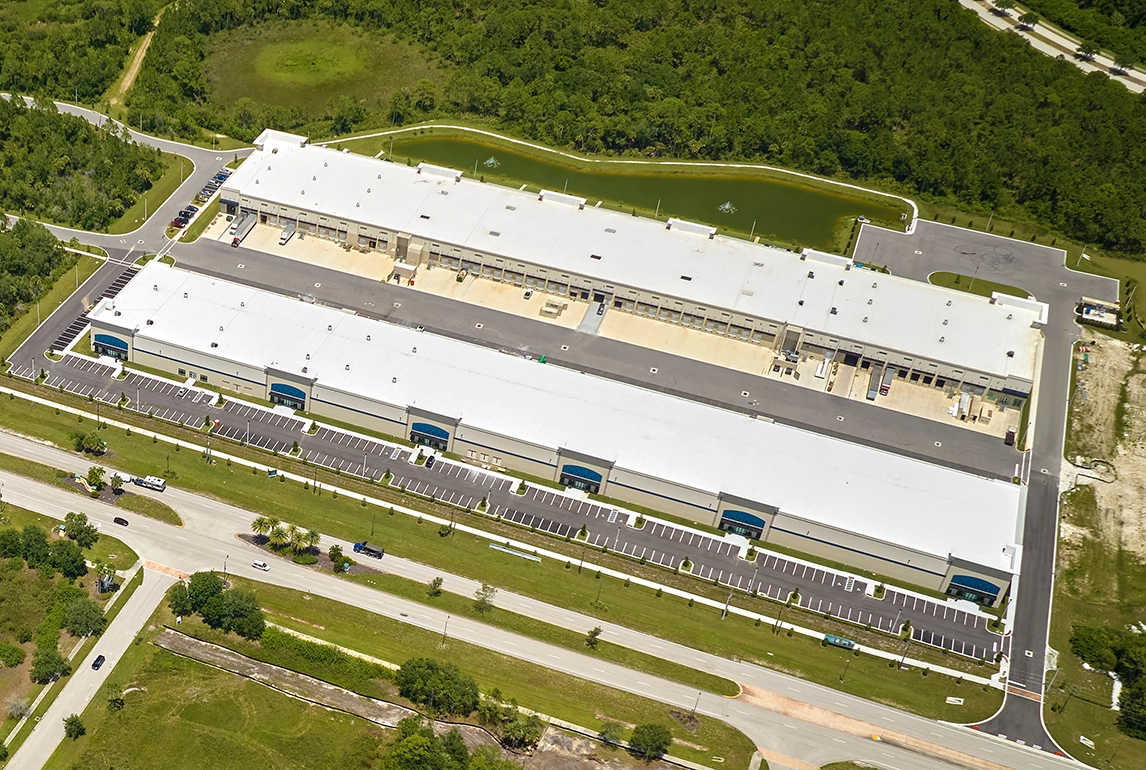Mega Warehouses & How to Maintain a Large Roof
If you drive on any major interstate highway these days, you can’t help but notice the enormously large distribution centers for stores like Amazon and Walmart. But such large warehouses aren’t just limited to e-commerce stores; warehousing is an essential part of the global supply chain and plays a critical role in the success of all businesses.

According to Forbes magazine, the Department of Energy estimates there are approximately 725,00 warehouses in the U.S. With some of these warehouses measuring several square miles in size, the commercial roof systems of these structures are equally as large as the warehouses. Although there are many different commercial roof types, most mega warehouse roofs are flat.
When it comes to flat roofs, several types could encompass your commercial facility including built-up, modified bitumen, single-ply membrane—TPO and EPDM, PVC, spray polyurethane foam, and metal.
But, no matter what type of commercial roof you have, it can be difficult to know how to maintain such a large area. Below are some suggestions for preserving your mega warehouse roof that are crucial for prolonging its lifespan, ensuring its structural integrity, and preventing costly repairs.
Regular Inspections
The number one thing a facility manager can do to maintain a large roof is inspect it regularly. Conduct a bi-annual industrial roof inspection—preferably in the spring and fall—to ensure small problems don’t become big problems and eventually cause a roofing emergency.
During a regular inspection, you should:
- Look for signs of wear, loose materials, ponding water, cracks, and any potential for leaks, especially around seams, drains, HVAC units, and other items penetrating the roof.
- Inspect seals, flashing, and other waterproofing elements for any signs of deterioration. Have these items replaced or repaired, when necessary, as well as reinforce vulnerable areas. Common stress points include HVAC units, skylights, and other protrusions. Reinforcing these areas can help prevent water infiltration. (duplication)
- Monitor and repair membrane damage by inspecting for tears. Roof membranes can be damaged by foot traffic, weather, and debris. Even small tears or punctures can lead to significant issues.
In addition to conducting regular commercial roof inspections, also examine your rooftop after a severe storm. High winds and rain can create issues and may need to be addressed before you have an emergency roofing repair on your hands.
Clear Debris
It’s also important to ensure your warehouse roof is free of debris. If you don’t remove sticks, leaves, and other materials that collect on the rooftop over time, the drains, gutters, and downspouts can become clogged, causing water to pond, which can damage membranes and lead to leaks.
Minimize Water Collection
To prevent roof ponding, other items should be checked. First, ensure you have good slope maintenance. Make sure the slope and drains are adequate to prevent water from collecting, which adds unnecessary weight to the roof and can cause membrane degradation. Second, you should evaluate your roof drainage systems; consider installing additional drains or sump pumps if ponding water becomes a recurring issue. Check out these tips to prevent ponding water on your roof.
Roof Coatings and Protective Layers
Commercial roof coatings and protective layers can also help maintain your roof and are crucial for prolonging its lifespan. UV rays and heat can deteriorate the roof membrane over time; however, putting a reflective coating on your rooftop will help to reduce heat absorption that can extend the life of your roof, as well as lower cooling costs. Be sure to use a reputable roof coating contractor. You can also install protective mats to prolong your roof’s lifespan. All rooftops should have pathways that are clearly marked so employees know where to walk when on the roof deck which will also reduce wear and damage on the roof membrane.
Maintenance Plan
In addition to conducting regular inspections, it is also advisable to hire a professional roofing company like Capital Roof Care (CRC) to set up a roof maintenance plan. There are so many things to oversee when managing a mega warehouse, your roof doesn’t need to be one of them. CRC offers a variety of commercial roof maintenance plans to alleviate your stress and worry, so you can pay attention to your mission-critical responsibilities. When you purchase a maintenance plan from CRC, they will serve as your partner and:
- Organize, keep track of your roof warranty information, and follow the maintenance requirements to keep it valid
- Regularly assess the conditions of your roof
- Identify repair needs
- Document all roof maintenance assessments and repair activities
Having an ongoing roof maintenance plan has many benefits including reduced cost of ownership, compliance peace of mind, and the ability to forecast and plan ahead. This planning is especially important when it comes to your facility’s budget and repair costs. By knowing what to expect, mega warehouse facility managers can allocate funds specifically for roof maintenance or an industrial roof replacement.
No matter what type of commercial roof you have, facility managers can prevent problems before they start by conducting inspections, clearing debris, minimizing water collection, having the right roof coatings and protective layers, and implementing a maintenance plan. When you partner with a trusted professional like CRC, you will ensure the longevity, performance, and safety of your commercial mega warehouse roof.
Sources: